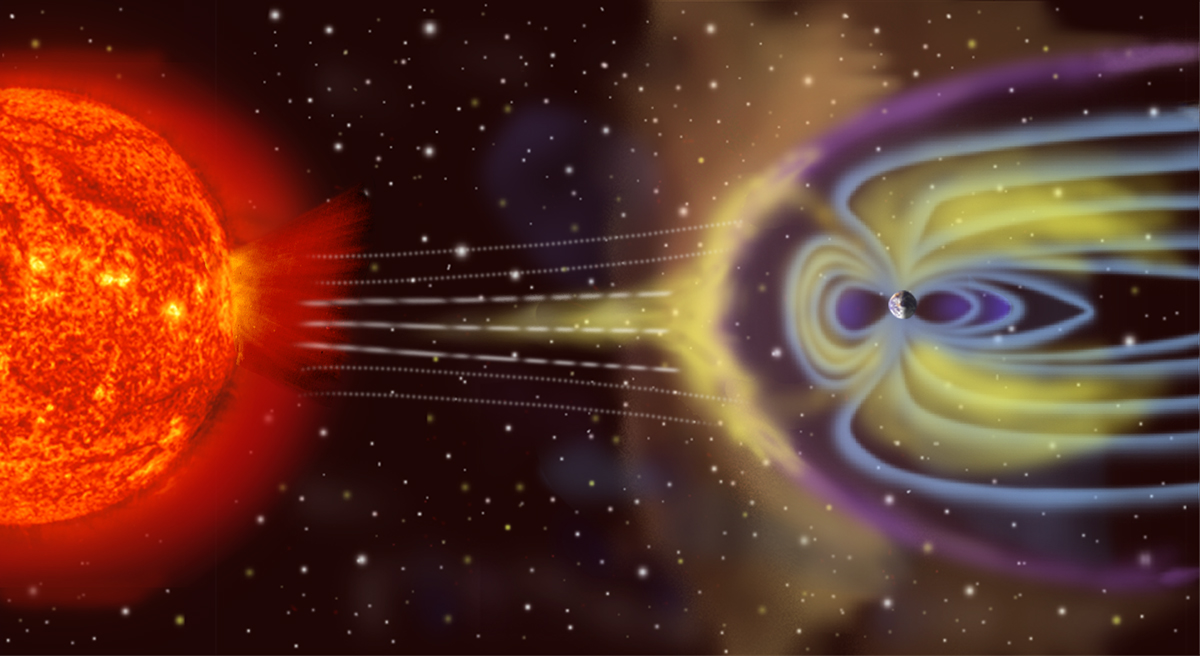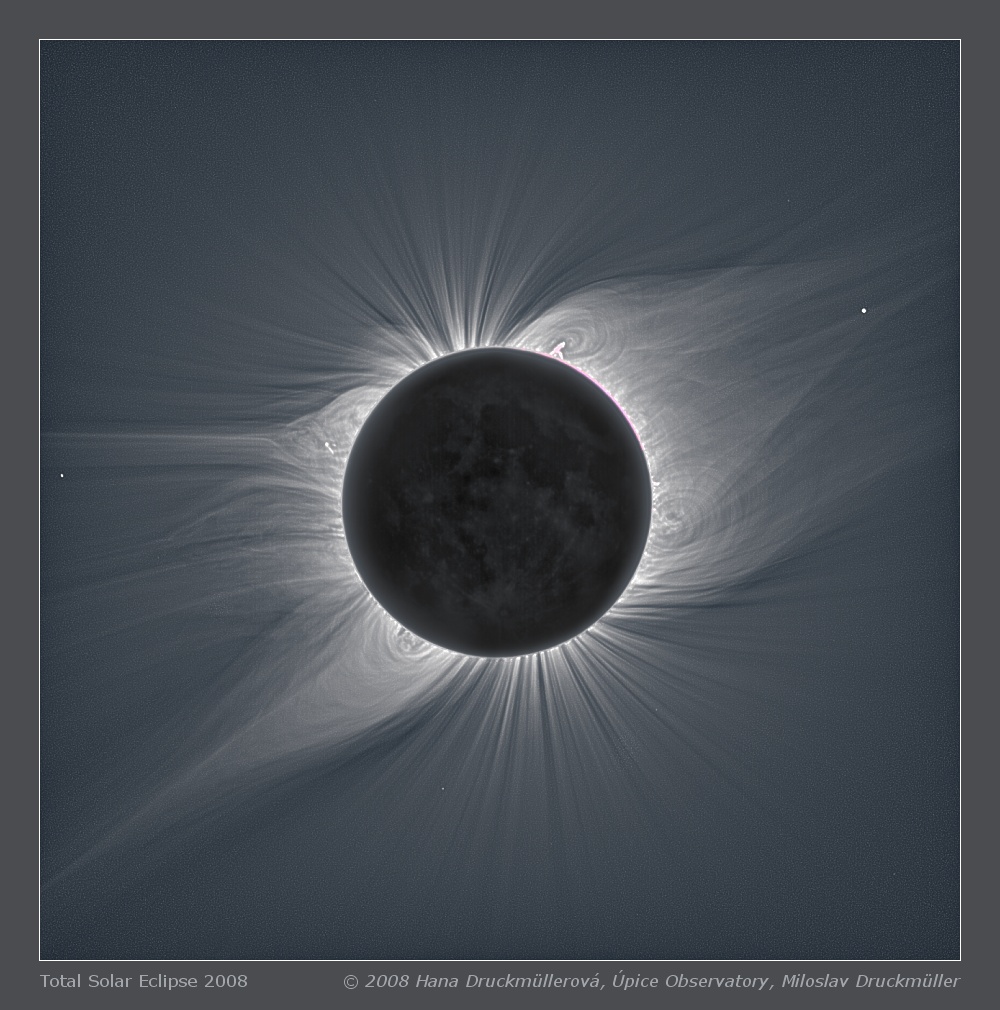An Introduction to the Sun-Earth connection

An artist's rendition of the solar terrestrial system
The Sun has long fascinated scientists and astronomers and has even been worshipped in ancient times. In fact, one of the longest recorded time series is that of sunspot numbers, which fluctuates with an eleven year cycle. Sunspots are a darker cooler area on the Sun’s photosphere (the visible surface) which are associated with intense magnetic fields. While the records of sunspots are available from medieval times, it is a fairly recent development (last 200 years) that we understood the Sun's influence is not limited to light and heat. In the late 19th century through a chance observation Richard Carrington observed a solar flare on the surface of the Sun. Surprised by this he called his assistant over, but in the few minutes it took him to arrive, the brightness had diminished significantly. A day or two later there was a huge geomagnetic storm at Earth, that had catastrophic consequences for telegraph communication. Huge auroural displays (the Northern/Southern Lights) were seen across the world. While geomagnetic storms were routinely seen in the polar regions this was perhaps the first indication that it was to do with activity on the Sun. The dangers associated with space weather are perhaps more relevant now than ever before. Our modern society is increasingly reliant on computers and satellites, which can be damaged or temporarily disabled by space weather. Reliable and accurate forecasting for space weather is essential in the digital age. This begins with being able to predict when the Sun is likely to emit a flare or a CME (Coronal Mass Ejection- an expulsion of matter from the corona), followed by modelling the trajectories of any CMEs to determine whether they will hit Earth. In the following sections we will discuss the solar interior and its outer atmosphere, the solar wind, and the effects seen at Earth which manifest themselves as the fabulous auroras in the upper atmosphere.
The Solar Interior
The Sun is giant ball of plasma (a hot charged gas), which has several distinct layers. The centre up to around 25% of its radius is classed as the core, this is the engine room of the Sun where all the energy is produced through nuclear fusion. This is a process where smaller nuclei combine to form larger nuclei releasing energy in the process. The net result of the reactions is that four protons are combined into a helium nucleus releasing energy in the form of gamma rays. For this reaction to take place the temperature of the plasma is required to be around 14MK. Above the core are two regions termed the radiative and convective zones, where the radiative zone extends from the top of the core to a height roughly 75% of the solar radius, and the remainder is the convective zone. Here we can use an analogy of a saucepan of water to explain the process of convection. In a pan of water hotter regions rise to the surface and cool, sinking back down and forming cell-like patterns on the surface. This is the process which also occurs in the convective zone. Cellular patterns of convection seen on the solar surface are evidence of this. However, in the middle radiative zone, the plasma is too dense for convection to be efficient. Here the dominant transport of energy is through electromagnetic radiation. In summary we have the core where the energy is produced (0-25% of the solar radius), the radiative zone (25-75%) where energy is transported through radiation and then the convective zone (75-100%), where convection transfers the energy. We are now at the observable surface- the photosphere.

Image of the granular convection patterns. Reproduced under creative commons Image by G. Scharner
The Solar Atmosphere

Image of the chromosphere and corona from an eclipse observation in Russia 2006. Courtesy of Miloslav Druckmuller.
Since the Sun does not have a solid surface the scientific convention has become to denote the photosphere as the Sun's surface. This is the white light emitting region which is visible to us. This region is a few 100km thick and has a temperature of around 6,000K. Sometimes cooler regions appear on the Sun called sunspots, these appear as dark blotches and have a cooler temperature of around 3,000K. These regions are associated with intense magnetic fields. Above this region we find the chromosphere, which is another thin (hundreds of km) layer characterised by a blood-red tinge when viewed in visible light, and has a puzzlingly higher temperature (20,000K) than the photosphere beneath it. Sometimes phenomena such as prominences are seen at the edges of the disk, these are loops of plasma which are confined by magnetic fields. The final part of the Sun's atmosphere is the corona (meaning ‘crown’) which is very diffuse and extends out to several solar radii. The corona can only be viewed when bright visible light coming directly from the photosphere is blocked. This can be done by looking at specific wavelengths (which correspond to very hot plasma) or by blocking out the light from Sun's surface. For this purpose an occulting disk can be placed in front of your telescope such as that on SOHO's LASCO instrument (Solar and Heliospheric Observatory’s Large Angle and Spectrometric Coronagraph), or by observing the Sun during a solar eclipse. Solar eclipses are especially advantageous since the optical effects are much less prominent when compared to placeing an occulting disk on a telescope. The data gathered during solar eclipses then gives us a unique opportunity to see the very low corona, which may hold the key to understanding the heating in the corona. Coronal heating has been one of the biggest mysteries in modern physics, the corona itself is much hotter than the chromosphere beneath it, with temperatures reaching 1-2MK. This seems rather counter intuitive, since at the lowest level of the atmosphere we have the coldest region and as we move further from the energy source (the Sun), the plasma becomes far hotter!This is one of the large outstanding problems in solar physics and is called the coronal heating problem. Some explanations invoke a large number of nano/pico flares (seen by small transient emissions of X-rays), or magnetic waves, where the magnetic field vibrates like a string on a guitar and transfers energy into heating the plasma. As we go to higher and higher altitudes (around 15 solar radii) the outflowing corona transitions to the solar wind, which is the name for the collection of particles expelled continuously from the Sun.
Solar Eclipses
By a lucky conincidence the Moon has a very similar angular size to the Sun. During an eclipse the Moon passes in front of us blocking our view of the Sun's visible surface (the photosphere). This gives an excellent opportunity to study the more tenuous outer atmosphere of the Sun; the corona, which is difficult if not impossible to image without blocking the intense light from the photosphere. Historically eclipses were thought to be miracles or bad omens, and have been mentioned in several historical records. However during the enlightenment these events began to be studied from a scientific perspective. Allthough the duration of a total eclipse is rather brief they offer unique windows to study the outer atmosphere of the Sun. Indeed one of the first coronal mass ejections observed was done so with the aid of a solar eclipse (pictured right). In modern times instead of sketches drawn by hand sophisticated cameras are used with a variety of filters to study different temperatures and images are enhanced to see features too elusive for the human eye. Solar eclipses remain the best method to look at the solar corona between distances of 1.4 to 2 solar radii.
